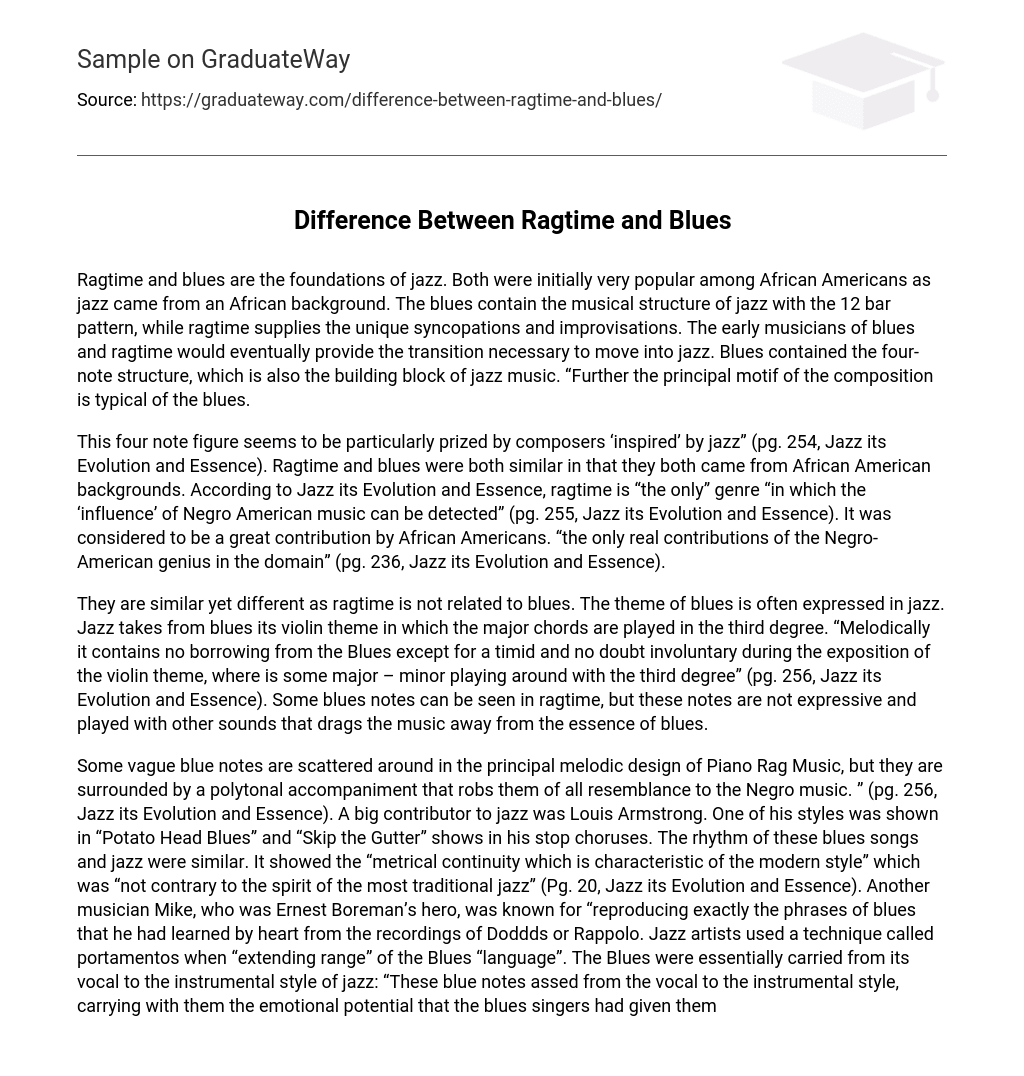Ragtime and blues are the foundations of jazz. Both were initially very popular among African Americans as jazz came from an African background. The blues contain the musical structure of jazz with the 12 bar pattern, while ragtime supplies the unique syncopations and improvisations. The early musicians of blues and ragtime would eventually provide the transition necessary to move into jazz. Blues contained the four-note structure, which is also the building block of jazz music. “Further the principal motif of the composition is typical of the blues.
This four note figure seems to be particularly prized by composers ‘inspired’ by jazz” (pg. 254, Jazz its Evolution and Essence). Ragtime and blues were both similar in that they both came from African American backgrounds. According to Jazz its Evolution and Essence, ragtime is “the only” genre “in which the ‘influence’ of Negro American music can be detected” (pg. 255, Jazz its Evolution and Essence). It was considered to be a great contribution by African Americans. “the only real contributions of the Negro-American genius in the domain” (pg. 236, Jazz its Evolution and Essence).
They are similar yet different as ragtime is not related to blues. The theme of blues is often expressed in jazz. Jazz takes from blues its violin theme in which the major chords are played in the third degree. “Melodically it contains no borrowing from the Blues except for a timid and no doubt involuntary during the exposition of the violin theme, where is some major – minor playing around with the third degree” (pg. 256, Jazz its Evolution and Essence). Some blues notes can be seen in ragtime, but these notes are not expressive and played with other sounds that drags the music away from the essence of blues.
Some vague blue notes are scattered around in the principal melodic design of Piano Rag Music, but they are surrounded by a polytonal accompaniment that robs them of all resemblance to the Negro music. ” (pg. 256, Jazz its Evolution and Essence). A big contributor to jazz was Louis Armstrong. One of his styles was shown in “Potato Head Blues” and “Skip the Gutter” shows in his stop choruses. The rhythm of these blues songs and jazz were similar. It showed the “metrical continuity which is characteristic of the modern style” which was “not contrary to the spirit of the most traditional jazz” (Pg. 20, Jazz its Evolution and Essence). Another musician Mike, who was Ernest Boreman’s hero, was known for “reproducing exactly the phrases of blues that he had learned by heart from the recordings of Doddds or Rappolo. Jazz artists used a technique called portamentos when “extending range” of the Blues “language”. The Blues were essentially carried from its vocal to the instrumental style of jazz: “These blue notes assed from the vocal to the instrumental style, carrying with them the emotional potential that the blues singers had given them. ” (Pg. 26, Jazz its Evolution and Essence). Ragtime and Blues were similar in that both came from African-American backgrounds,“Ragtime was the first black music ever to achieve widespread popularity and commercial distribution” (pg. 19, Jazz: A History).
Ragtime was mostly based on the piano, which was the “principal instrument of ragtime” (pg. 19, Jazz: A History). Ragtime came from the South. The instruments used to play ragtime, banjo, fiddle, fife, were instruments that were considered to be “prototypes brought to this country from Africa” (pg. 0, Jazz: A History). Ragtime music had a duple meter. It had a “functional diatonic harmony stressing tonic, dominant, subdominant, and applied dominants in a major tonality” (pg. 22, Jazz: A History). Its syncopations occurred on the second and fourth eighth notes with accented melody notes. Syncopation, an “interruption of the regular flow of rhythm”, was the “ chief characteristic” of ragtime melodies. Ragtime, when played on the piano, had a “stride style”, in which the “pianist’s left hand” was “called to ‘stride’ up and down” (pg. 3, Jazz: A History). Jelly Role Morton and James P. Johnson were well known for stride playing and are “viewed as transitional figures” from ragtime to jazz (pg. 24, Jazz: A History). Tom Turpin, a musician who composed excellent music, composed rags that were in the ABA form, unlike the blues, which were usually in the AABA form. Scott Joplin, another ragtime musician, made a bigger contribution. His most famous work, “The Maple Leaf Rag”, sold hundreds of thousands of copies. Joplin was “not interested” in “haphazard” improvisations.
He wanted to make “classical” ragtime comparable to Classic European music that would be “used in the larger, traditional forms such as operas and symphonies” (pg. 29, Jazz: A History). The blues are considered to be the “center of the jazz tradition” and dates back to the earliest days of jazz. The 12-bar blues are still at the “heart” of modern jazz. The Blues are a distinct form of jazz: “When a musician says let’s play the blues, he means something quite specific” (pg. 99, Jazz: A History). The “cry or holler” was the most important characteristic of the blues, which is prominent in Jazz itself.





